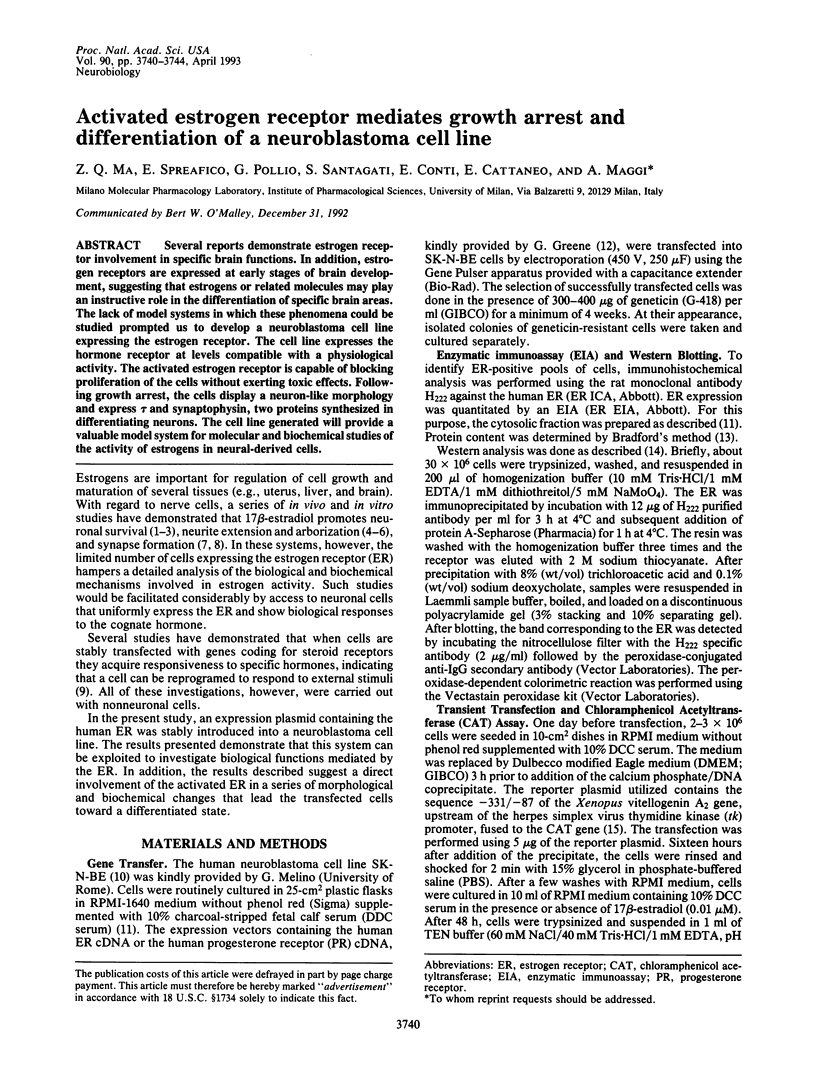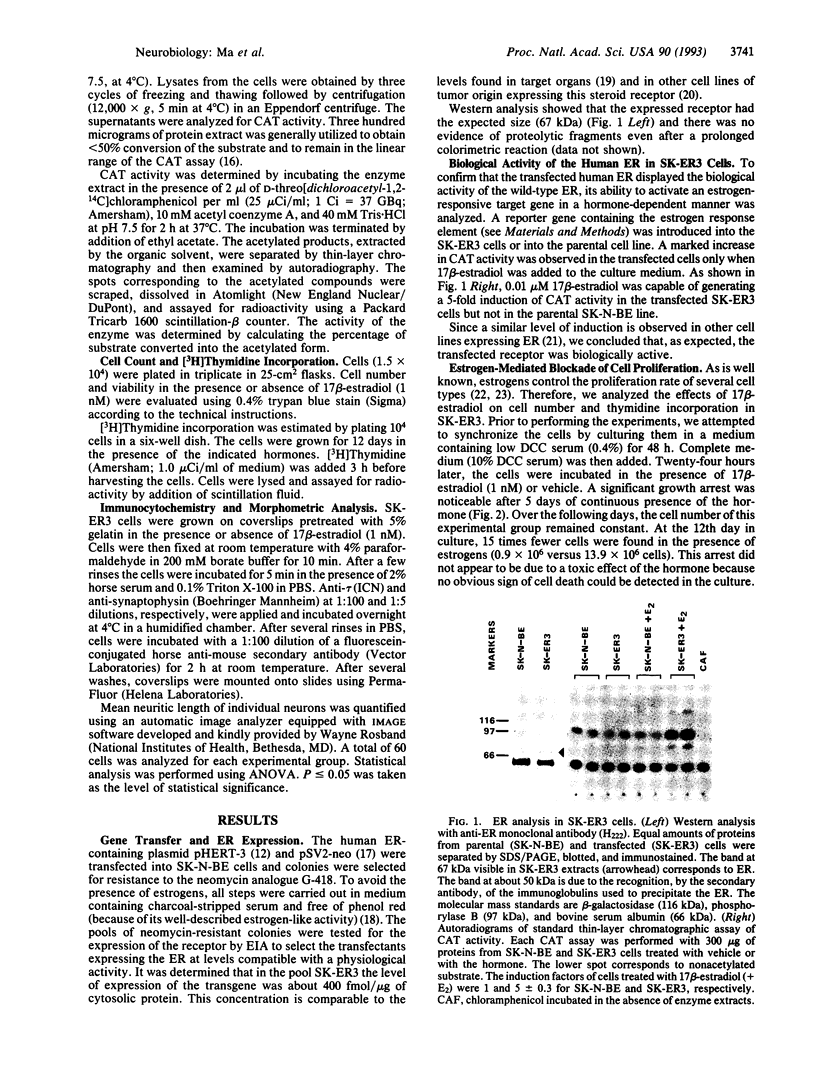Abstract
Several reports demonstrate estrogen receptor involvement in specific brain functions. In addition, estrogen receptors are expressed at early stages of brain development, suggesting that estrogens or related molecules may play an instructive role in the differentiation of specific brain areas. The lack of model systems in which these phenomena could be studied prompted us to develop a neuroblastoma cell line expressing the estrogen receptor. The cell line expresses the hormone receptor at levels compatible with a physiological activity. The activated estrogen receptor is capable of blocking proliferation of the cells without exerting toxic effects. Following growth arrest, the cells display a neuron-like morphology and express tau and synaptophysin, two proteins synthesized in differentiating neurons. The cell line generated will provide a valuable model system for molecular and biochemical studies of the activity of estrogens in neural-derived cells.
Full text
PDF




Images in this article
Selected References
These references are in PubMed. This may not be the complete list of references from this article.
- Arai Y., Matsumoto A. Synapse formation of the hypothalamic arcuate nucleus during post-natal development in the female rat and its modification by neonatal estrogen treatment. Psychoneuroendocrinology. 1978 Jan;3(1):31–45. doi: 10.1016/0306-4530(78)90039-2. [DOI] [PubMed] [Google Scholar]
- Berthois Y., Katzenellenbogen J. A., Katzenellenbogen B. S. Phenol red in tissue culture media is a weak estrogen: implications concerning the study of estrogen-responsive cells in culture. Proc Natl Acad Sci U S A. 1986 Apr;83(8):2496–2500. doi: 10.1073/pnas.83.8.2496. [DOI] [PMC free article] [PubMed] [Google Scholar]
- Biedler J. L., Roffler-Tarlov S., Schachner M., Freedman L. S. Multiple neurotransmitter synthesis by human neuroblastoma cell lines and clones. Cancer Res. 1978 Nov;38(11 Pt 1):3751–3757. [PubMed] [Google Scholar]
- Birren S. J., Anderson D. J. A v-myc-immortalized sympathoadrenal progenitor cell line in which neuronal differentiation is initiated by FGF but not NGF. Neuron. 1990 Feb;4(2):189–201. doi: 10.1016/0896-6273(90)90094-v. [DOI] [PubMed] [Google Scholar]
- Bradford M. M. A rapid and sensitive method for the quantitation of microgram quantities of protein utilizing the principle of protein-dye binding. Anal Biochem. 1976 May 7;72:248–254. doi: 10.1016/0003-2697(76)90527-3. [DOI] [PubMed] [Google Scholar]
- Cattaneo E., Maggi A. c-fos induction by estrogen in specific rat brain areas. Eur J Pharmacol. 1990 Mar 13;188(2-3):153–159. doi: 10.1016/0922-4106(90)90050-8. [DOI] [PubMed] [Google Scholar]
- Cattaneo E., McKay R. Proliferation and differentiation of neuronal stem cells regulated by nerve growth factor. Nature. 1990 Oct 25;347(6295):762–765. doi: 10.1038/347762a0. [DOI] [PubMed] [Google Scholar]
- Cheson B. D. The maturation of differentiation therapy. N Engl J Med. 1992 Aug 6;327(6):422–424. doi: 10.1056/NEJM199208063270612. [DOI] [PubMed] [Google Scholar]
- Drubin D., Kobayashi S., Kirschner M. Association of tau protein with microtubules in living cells. Ann N Y Acad Sci. 1986;466:257–268. doi: 10.1111/j.1749-6632.1986.tb38398.x. [DOI] [PubMed] [Google Scholar]
- Faivre-Bauman A., Rosenbaum E., Puymirat J., Grouselle D., Tixier-Vidal A. Differentiation of fetal mouse hypothalamic cells in serum-free medium. Dev Neurosci. 1981;4(2):118–129. doi: 10.1159/000112747. [DOI] [PubMed] [Google Scholar]
- Ferreira A., Caceres A. Estrogen-enhanced neurite growth: evidence for a selective induction of Tau and stable microtubules. J Neurosci. 1991 Feb;11(2):392–400. doi: 10.1523/JNEUROSCI.11-02-00392.1991. [DOI] [PMC free article] [PubMed] [Google Scholar]
- Frankfurt M., Gould E., Woolley C. S., McEwen B. S. Gonadal steroids modify dendritic spine density in ventromedial hypothalamic neurons: a Golgi study in the adult rat. Neuroendocrinology. 1990 May;51(5):530–535. doi: 10.1159/000125387. [DOI] [PubMed] [Google Scholar]
- Fujimoto M., Yoshino E., Hirakawa K., Fujimoto J., Tamaya T. Estrogen receptors in brain tumors. Clin Neuropharmacol. 1984;7(4):357–362. doi: 10.1097/00002826-198412000-00015. [DOI] [PubMed] [Google Scholar]
- Gahr M., Konishi M. Developmental changes in estrogen-sensitive neurons in the forebrain of the zebra finch. Proc Natl Acad Sci U S A. 1988 Oct;85(19):7380–7383. doi: 10.1073/pnas.85.19.7380. [DOI] [PMC free article] [PubMed] [Google Scholar]
- Horwitz K. B., Zava D. T., Thilagar A. K., Jensen E. M., McGuire W. L. Steroid receptor analyses of nine human breast cancer cell lines. Cancer Res. 1978 Aug;38(8):2434–2437. [PubMed] [Google Scholar]
- Kiss R., de Launoit Y., Danguy A., Paridaens R., Pasteels J. L. Influence of fetal calf serum in combination with pharmacological doses of progesterone or estradiol on proliferation and cell cycle kinetics of cultured mammary cancer cells. Oncology. 1989;46(6):391–399. doi: 10.1159/000226759. [DOI] [PubMed] [Google Scholar]
- Klein-Hitpass L., Ryffel G. U., Heitlinger E., Cato A. C. A 13 bp palindrome is a functional estrogen responsive element and interacts specifically with estrogen receptor. Nucleic Acids Res. 1988 Jan 25;16(2):647–663. doi: 10.1093/nar/16.2.647. [DOI] [PMC free article] [PubMed] [Google Scholar]
- Kushner P. J., Hort E., Shine J., Baxter J. D., Greene G. L. Construction of cell lines that express high levels of the human estrogen receptor and are killed by estrogens. Mol Endocrinol. 1990 Oct;4(10):1465–1473. doi: 10.1210/mend-4-10-1465. [DOI] [PubMed] [Google Scholar]
- Loose-Mitchell D. S., Chiappetta C., Stancel G. M. Estrogen regulation of c-fos messenger ribonucleic acid. Mol Endocrinol. 1988 Oct;2(10):946–951. doi: 10.1210/mend-2-10-946. [DOI] [PubMed] [Google Scholar]
- Martin D. M., Yee D., Carlson R. O., Feldman E. L. Gene expression of the insulin-like growth factors and their receptors in human neuroblastoma cell lines. Brain Res Mol Brain Res. 1992 Oct;15(3-4):241–246. doi: 10.1016/0169-328x(92)90114-q. [DOI] [PubMed] [Google Scholar]
- Rasmussen J. E., Torres-Aleman I., MacLusky N. J., Naftolin F., Robbins R. J. The effects of estradiol on the growth patterns of estrogen receptor-positive hypothalamic cell lines. Endocrinology. 1990 Jan;126(1):235–240. doi: 10.1210/endo-126-1-235. [DOI] [PubMed] [Google Scholar]
- Rasmussen J. E., Torres-Aleman I., MacLusky N. J., Naftolin F., Robbins R. J. The effects of estradiol on the growth patterns of estrogen receptor-positive hypothalamic cell lines. Endocrinology. 1990 Jan;126(1):235–240. doi: 10.1210/endo-126-1-235. [DOI] [PubMed] [Google Scholar]
- Sorrentino J. M., Kirkland W. L., Sirbasku D. A. Control of cell growth. I. Estrogen-dependent growth in vivo of a rat pituitary tumor cell line. J Natl Cancer Inst. 1976 Jun;56(6):1149–1154. doi: 10.1093/jnci/56.6.1149. [DOI] [PubMed] [Google Scholar]
- Strähle U., Boshart M., Klock G., Stewart F., Schütz G. Glucocorticoid- and progesterone-specific effects are determined by differential expression of the respective hormone receptors. Nature. 1989 Jun 22;339(6226):629–632. doi: 10.1038/339629a0. [DOI] [PubMed] [Google Scholar]
- Tora L., Gaub M. P., Mader S., Dierich A., Bellard M., Chambon P. Cell-specific activity of a GGTCA half-palindromic oestrogen-responsive element in the chicken ovalbumin gene promoter. EMBO J. 1988 Dec 1;7(12):3771–3778. doi: 10.1002/j.1460-2075.1988.tb03261.x. [DOI] [PMC free article] [PubMed] [Google Scholar]
- Toran-Allerand C. D., Ellis L., Pfenninger K. H. Estrogen and insulin synergism in neurite growth enhancement in vitro: mediation of steroid effects by interactions with growth factors? Brain Res. 1988 Jun 1;469(1-2):87–100. doi: 10.1016/0165-3806(88)90172-1. [DOI] [PubMed] [Google Scholar]
- Toran-Allerand C. D. Sex steroids and the development of the newborn mouse hypothalamus and preoptic area in vitro: implications for sexual differentiation. Brain Res. 1976 Apr 23;106(2):407–412. doi: 10.1016/0006-8993(76)91038-6. [DOI] [PubMed] [Google Scholar]
- Touitou I., Mathieu M., Rochefort H. Stable transfection of the estrogen receptor cDNA into Hela cells induces estrogen responsiveness of endogenous cathepsin D gene but not of cell growth. Biochem Biophys Res Commun. 1990 May 31;169(1):109–115. doi: 10.1016/0006-291x(90)91440-4. [DOI] [PubMed] [Google Scholar]
- Vegeto E., Cocciolo M. G., Raspagliesi F., Piffanelli A., Fontanelli R., Maggi A. Regulation of progesterone receptor gene expression. Cancer Res. 1990 Sep 1;50(17):5291–5295. [PubMed] [Google Scholar]
- Watts C. K., Parker M. G., King R. J. Stable transfection of the oestrogen receptor gene into a human osteosarcoma cell line. J Steroid Biochem. 1989;34(1-6):483–490. doi: 10.1016/0022-4731(89)90132-5. [DOI] [PubMed] [Google Scholar]
- Weisz A., Bresciani F. Estrogen induces expression of c-fos and c-myc protooncogenes in rat uterus. Mol Endocrinol. 1988 Sep;2(9):816–824. doi: 10.1210/mend-2-9-816. [DOI] [PubMed] [Google Scholar]
- Wernette-Hammond M. E., Lauer S. J., Corsini A., Walker D., Taylor J. M., Rall S. C., Jr Glycosylation of human apolipoprotein E. The carbohydrate attachment site is threonine 194. J Biol Chem. 1989 May 25;264(15):9094–9101. [PubMed] [Google Scholar]
- Wiedenmann B., Franke W. W. Identification and localization of synaptophysin, an integral membrane glycoprotein of Mr 38,000 characteristic of presynaptic vesicles. Cell. 1985 Jul;41(3):1017–1028. doi: 10.1016/s0092-8674(85)80082-9. [DOI] [PubMed] [Google Scholar]






